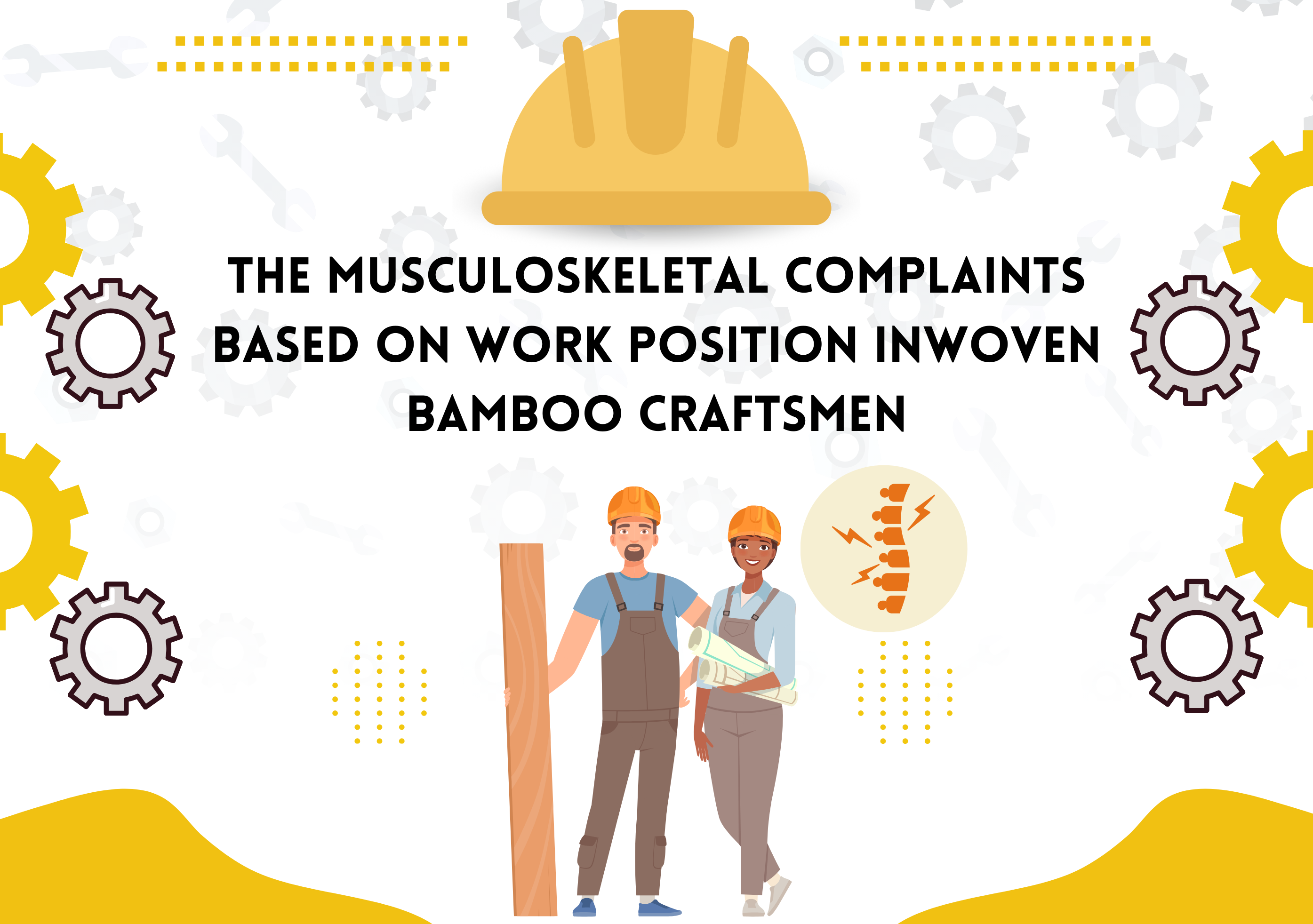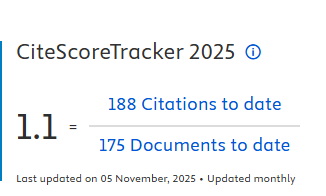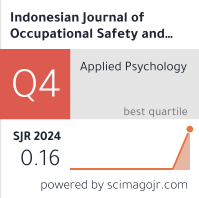The Musculoskeletal Complaints Based on Work Position inWoven Bamboo Craftsmen

Downloads
Introduction: Musculoskeletal disorders in Indonesia require attention due to their high prevalence. Woven bamboo craft production involves unnatural body postures at every stage, leading to potential injuries. Assessing musculoskeletal complaints can provide valuable data for ergonomic risk assessment. This study aims to analyze such complaints based on the working positions of bamboo weavers. Methods: This research is descriptive. The population in this study was all woven bamboo craftsmen with a total of 430 people. The total sample was 86 craftsmen from 20% of the population for descriptive research. The variables studied included work position and musculoskeletal complaints. Data collection was done by observation and survey. Data were analyzed descriptively by displaying the calculation results of the risk level of work positions and the risk level of musculoskeletal complaints. Results: Most of the work positions of craftsmen are in the medium-risk category (54.7%). The working position of the craftsmen who have very high-risk category is at the stage of making woven bamboo and finishing. The highest level of discharge risk is in the low complaint category (60.5%), and the high category of musculoskeletal complaints is at the stage of making the woven. Conclusion: The working position of the woven bamboo craftsmen is directly proportional to the complaints they feel. Intervention is needed to reduce the risk of injury and reduce musculoskeletal complaints felt by workers, especially in workers with very high-risk working positions.
Abdillah, M. A. A. N. (2011) Perancangan Ulang Tempat Kerja Operator Dengan Pendekatan Ergonomi Partisipatori Untuk Mengurangi Keluhan Muskuloskeletal dan Kelelahan. Undergraduate Thesis. Yogyakarta: Faculty of Industria Technology Universitas Islam Indonesia.
Ahmad, N.P., Hidayat, R. and Hamdani, R. (2021) ‘Analisis Postur Kerja Dengan Metode Rula Pada Operator Las Di Bengkel Las Sumber Jaya Bekasi, Jawa Barat', Bulletin of Applied Industrial Engineering Theory, 2(1).
Anggraika, P., Apriany, A. and Pujiana, D. (2019) ‘Hubungan Posisi Duduk dengan Kejadian Low Back Pain (LBP) pada Pegawai STIKES', Jurnal'Aisyiyah Medika, 4(1), pp. 1–10.
BPS Kabupaten Tasikmalaya (2020) Kecamatan Leuwisari dalam Angka 2020. Tasikmalaya: BPS Tasikmalaya.
BSN (2021) Keputusan Badan Standardisasi Nasional Nomor 509/KEP/BSN/12/2021 Tentang Penetapan SNI 9011:2011 Pengukuran dan Evaluasi Potensi Bahaya Ergonomi di Tempat Kerja, Badan Standardisasi Nasional . Indonesia.
Centers of Disease Control and Prevention (2020) Work-Related Musculoskeletal Disorders &Ergonomics, Centers of Disease Control and Prevention. Available at: https://www.cdc.gov/workplacehealthpromotion/health-strategies/musculoskeletal-disorders/index.html (Accessed: 30 November 2021).
Dianat, I., Hasanpour, M. and Shahravan, A. (2018) ‘Work-related Musculoskeletal Disorders among Iranian Dentists: A National Survey', Journal of Occupational Health, 60(2), pp. 183–193.
Evadarianto, N. and Dwiyanti, E. (2017) ‘Postur Kerja Dengan Keluhan Musculoskeletal Disorders Pada Pekerja Manual Handling Bagian Rolling Mill', The Indonesian Journal of Occupational Safety and Health, 6(1), pp. 97–106.
Gay, L.R., Mills, G.E., and Airasian, P.W. (2012) Educational research: competencies for analysis and applications. 10th edn. Boston: Pearson.
Hamdan, M. (2021) ‘Pengaruh Usia dan Jenis Kelamin pada Skala Nyeri Pasien Trigeminal Neuralgia', Jurnal Aksona, 1(2), pp. 53–56.
Ilman, A., Yuniar, Y. and Helianty, Y. (2013) ‘Rancangan perbaikan sistem kerja dengan metode Quick Exposure Check (QEC) di bengkel sepatu X di Cibaduyut', Reka Integra, 1(2).
Kementrian Kesehatan RI (2018) Hasil Utama RISKESDAS 2018. Jakarta.
Kurnianingtyas, C.D. (2017) ‘Perbaikan postur kerja untuk menurunkan gangguan musculoskeletal pada industri kecil kerajinan pembuatan sapu', Widya Teknik, 16(2), pp. 111–116.
Livandy, V. and Setiadi, T.H. (2018) ‘Prevalensi gangguan muskuloskeletal pada pekerja konfeksi bagian penjahitan di Kecamatan Pademangan Jakarta Utara periode Januari 2016', Tarumanagara Medical Journal, 1(1), pp. 183–191.
Middlesworth (2017) A Step-by-Step Guide Rapid Upper Limb Assessment (RULA), Ergonomics Plus Inc. Available at: http://www.ergo-plus.com/.
Ndari, P.W. and Roesdianto, R. (2018) ‘Analisis Postur Kerja dengan Metode Rula dan Redesign Peralatan Kerja untuk Mengurangi Risiko Musculoskeletal Disorder', Sinteks: Jurnal Teknik, 7(2), pp. 20–23.
Nurftah, L., Rini, W.N.E. and Ibnu, I.N. (2022) ‘Analisis Faktor Risiko Musculoskeletal Disorder (MSDs) Pada Pekerja Petik Teh di PT X Kayu Aro', Jambi Medical Journal: Jurnal Kedokteran dan Kesehatan, 10(2), pp. 172–185.
Oha, K. et al. (2021) ‘Risk Factors for Musculoskeletal Pain and Disability in Working-Age Adults: A Systematic Review', Scandinavian Journal of Work, Environment & Health, 47(2), pp. 75–104.
Pemerintah Indonesia (2018) Peraturan Menteri Ketenagakerjaan Republik Indonesia Nomor 5 Tahun 2018 Tentang Keselamatan Dan Kesehatan Kerja Lingkungan Kerja. Indonesia: Kementerian Ketenagakerjaan Republik Indonesia .
Prabarukmi, G.S. and Widajati, N. (2020) ‘The Correlation of Ergonomic Risk Factor with Musculoskeletal Complaints in Batik Workers Hubungan Faktor Risiko Ergonomi dengan Keluhan Muskuloskeletal pada Pembatik', The Indonesian Journal Of Occupational Safety and Health, 9(3), pp. 269–278.
Pramana, A.N., Kurniawan, B. and Ekawati, E. (2021) ‘Analisis Postur Kerja Dengan Menggunakan Metode Rapid Upper Limb Assessment (Rula) pada Pekerja di Laundry X Kota Semarang', Indonesian Journal of Health Community, 2(2), pp. 57–66.
Prayitno, S. and Hanum, B. (2018) ‘Analisa Postur Kerja Dengan Metode Rula Pada Operator Proses Masking FR Dan RR D30D Di PT SC Plant 2', Penelitian dan Aplikasi Sistem dan Teknik Industri, 12(1), p. 328408.
Revadi, C.E., Gunawan, C.S. and Rakasiwi, G.J. (2019) ‘Prevalensi Dan Faktor-Faktor Penyebab Musculoskeletal Disorders Pada Operator Gudang Industri Ban PT X Tangerang Indonesia', Jurnal Ergonomi Indonesia, 5(1), pp. 10–15.
Shobur, S., Maksuk, M. and Sari, F.I. (2019) ‘Faktor Risiko Musculoskeletal Disorders (MSDs) pada Pekerja Tenun Ikat di Kelurahan Tuan Kentang Kota Palembang', Jurnal Medikes (Media Informasi Kesehatan), 6(2), pp. 113–122.
Sigar, A.J.G., Suoth, L.F. and Rattu, J.A.M. (2019) ‘Hubungan Antara Posisi Kerja Duduk Dan Indeks Masa Tubuh Dengan Keluhan Musuloskeletal Pada Karyawan Di Bank Sulutgo Cabang Utama Manado', KESMAS, 8(7).
Sriagustini, I. and Supriyani, T. (2022) ‘Assessment of Work Posture on Woven Bamboo Craftsmen', The Indonesian Journal of Occupational Safety and Health, 11(2), pp. 295–306.
Sumampouw, O.J. and Joseph, G. (2022) ‘Hubungan Antara Posisi Kerja dan Usia dengan Keluhan Muskuloskeletal pada Nelayan', Health Care Jurnal Kesehatan, 11(1), pp. 34–42.
Suryanto, D., Ginanjar, R. and Fathimah, A. (2020) ‘Hubungan Risiko Ergonomi Dengan Keluhan Musculoskeletal Disorders (MSDs) Pada Pekerja Informal Bengkel Las Di Kelurahan Sawangan Baru Dan Kelurahan Pasir Putih Kota Depok Tahun 2019', Promotor, 3(1), pp. 41–49.
Tarwaka (2010) Ergonomi Industri Dasar-dasar Pengetahuan Ergonomi dan Aplikasi di tempat Kerja. Solo: Harapan press.
Tjahayuningtyas, A. (2019) ‘Faktor Yang Mempengaruhi Keluhan Musculoskeletal Disorders (MSDs) Pada Pekerja Informal Factors Affecting Musculoskeletal Disorders (MSDs) in Informal Workers', The Indonesian Journal of Occupational Safety and Health, 8(1), pp. 1–10.
WHO (2021) Musculoskeletal conditions, https://www.who.int/. Available at: https://www.who.int/news-room/fact-sheets/detail/musculoskeletal-conditions.
Yosineba, T.P., Bahar, E. and Adnindya, M.R. (2020) ‘Risiko Ergonomi dan Keluhan Musculoskeletal Disorders (MSDs) pada Pengrajin Tenun di Palembang', Jurnal Kedokteran dan Kesehatan: Publikasi Ilmiah Fakultas Kedokteran Universitas Sriwijaya, 7(1), pp. 60–66.

This work is licensed under a Creative Commons Attribution-NonCommercial-ShareAlike 4.0 International License.

In order to be accepted and published by The Indonesian Journal of Occupational Safety and Health, Author(s) who submit an article should complete all the review process. The copyright of received articles assigned to the The Indonesian Journal of Occupational Safety and Health and Department of Safety and Health, Universitas Airlangga as publishers of the journal. The intended copyright includes the rights to publish articles in various forms (including reprints).
The Editorial Team of The Indonesian Journal Of Occupational Safety and Health and Department of Safety and Health strive to ensure that no errors occur in the articles that have been published, both data errors and statements in the article.
Users of this website will be licensed to use materials from this website following the Creative Commons Attribution-NonCommercial-ShareAlike 4.0 International License. No fees charged. Please use the materials accordingly.
------------------------------------------------------------------------------------------------------------------------------------------------------------------------------------------
Attribution ” You must give appropriate credit, provide a link to the license, and indicate if changes were made. You may do so in any reasonable manner, but not in any way that suggests the licensor endorses you or your use.
NonCommercial ” You may not use the material for commercial purposes.
ShareAlike ” If you remix, transform, or build upon the material, you must distribute your contributions under the same license as the original.







 How to Submit Articles in OJS
How to Submit Articles in OJS

























